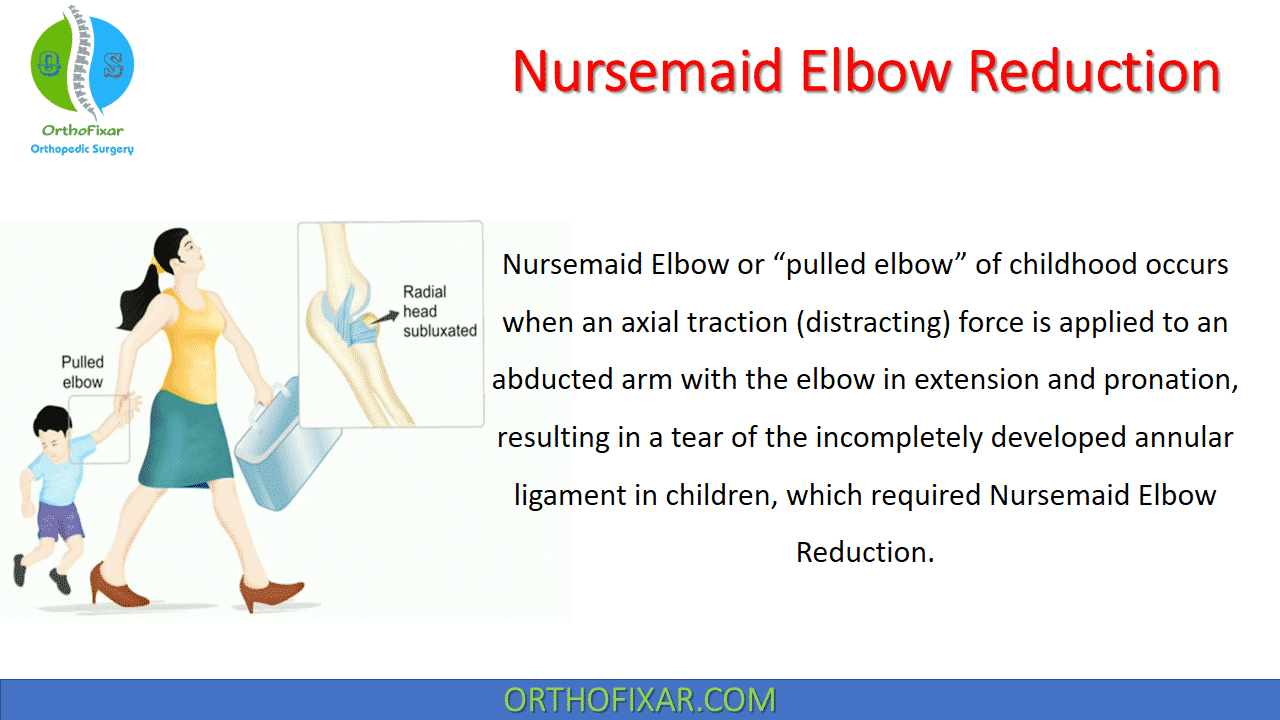Nursemaid Elbow Reduction

Nursemaid Elbow Reduction technique is a simple and easy serial of movements used by orthopedic surgeon to reduce the pulled elbow. It typically occurs in children less than 5 years old, with a range from as young as 3 months to 73 months.
Nursemaid Elbow or “pulled elbow” of childhood occurs when an axial traction (distracting) force is applied to an abducted arm with the elbow in extension and pronation, resulting in a tear of the incompletely developed annular ligament in children.
See Also: Nursemaid Elbow See Also: Elbow Anatomy

Nursemaid Elbow Reduction Maneuvers
Supination-flexion involves supination at the wrist followed by flexion at the elbow. This has been the standard nursemaid elbow reduction technique with which most physicians are familiar.
The Nursemaid Elbow Reduction technique is as follows:
- The thumb of the examiner is placed over the radial head of the patient’s affected arm. The examiner then grasps the patient’s wrist with the other hand.
- The patient’s elbow is passively positioned at 90° of flexion.
- The examiner then actively supinates the patient’s wrist to 90° in one steady movement, followed by actively flexing the patient’s elbow to maximal flexion. During this two-step maneuver, a palpable (or possibly audible) click should be elicited.

An alternative technique is the pronation or hyperpronation technique (with or without flexion). This technique was originally described as the preferred method of reduction by Hutchinson. The version of this technique, that is recommended is a variation on the “handshake” described by Lyver.
The hyperpronation technique of the Nursemaid Elbow Reduction is as follows:
- The thumb of the examiner is again placed over the radial head of the patient’s affected arm.
- The examiner then grasps the patients hand in a handshake with the examiner’s other hand.
- The examiner then actively pronates the patients hand until a palpable or audible click is elicited.
- If no click is appreciated by 90° of pronation, the patient’s hand is maximally hyperpronated. Mild flexion can be added to hyperpronation, although this is usually not necessary.

Several prospective studies have compared the two techniques. McDonald found equal success rates between the two maneuvers of Nursemaid Elbow Reduction, but found hyperpronation more successful when the left arm was involved and was judged to be less painful by the clinicians performing the procedure.
The occurrence of a palpable or audible click indicates that the annular ligament has been reduced with either technique.
The child will usually cry briefly at the time of reduction, followed by full use of the affected arm within 30 minutes.
A second attempt should be made with the same technique if Nursemaid Elbow Reduction is not achieved on the first attempt. If the second attempt is unsuccessful, then the alternate technique should be attempted, and if not successful on the first attempt, a second attempt may be performed. If reduction is not then achieved, a plaster posterior splint should be applied with referral in several days to a pediatric orthopedist for follow-up.
DISCHARGE PLANS FOLLOWING SUCCESSFUL REDUCTION
The parents should be informed that a recurrent nursemaid’s elbow is a possibility until complete development of the distal attachment of the annual ligament to the radial neck occurs usually by age 5.
It is acceptable to instruct the parents in the reduction technique that led to successful reduction so that they may attempt it prior to seeking medical care. In addition, it is reasonable to review the mechanism producing the injury with the parents and recommend avoiding the activity that resulted in the injury if at all possible.
Applying a splint or sling for a patient fully using the affected arm after Nursemaid Elbow Reduction is unnecessary and not recommended even in the setting of a recurrent nursemaid’s dislocation, which has a reported frequency as high as 25 percent.
References
- Bek D, Yildiz C, Köse O, Sehirlioğlu A, Başbozkurt M. Pronation versus supination maneuvers for the reduction of ‘pulled elbow’: a randomized clinical trial. Eur J Emerg Med. 2009 Jun;16(3):135-8. doi: 10.1097/MEJ.0b013e32831d796a. PMID: 19262394.
- Green DA. Randomized comparison of pain perception during radial head subluxation reduction using supination-flexion or forced pronation. Pediatric Emergency Care. 2006;22(4):235-8.
- McDonald J. Radial head subluxation: comparing two methods of reduction. Academic Emergency Medicine. 1999;6(7):715-8.
- Newman J. “Nursemaid’s elbow” in infants six months and under. Journal of Emergency Medicine. 1985;2:403-4
- Quan L. The epidemiology and treatment of radial head subluxation. American Journal of Diseases of Children. 1985;139:1194-7.
- Schunk J. Radial head subluxation: epidemiology and treatment of 87 episodes. 1990;19(9):1019-23.
- Lyver M. Radial head subluxation [letter]. Journal of Emergency Medicine. 1990;8:154-5.
- Teach S. Prospective study of recurrent radial head subluxation. Arch Pediatr Adolescent Medicine. 1996;150:164-6.
December 29, 2023
OrthoFixar
Orthofixar does not endorse any treatments, procedures, products, or physicians referenced herein. This information is provided as an educational service and is not intended to serve as medical advice.
- Lifetime product updates
- Install on one device
- Lifetime product support
- Lifetime product updates
- Install on one device
- Lifetime product support
- Lifetime product updates
- Install on one device
- Lifetime product support
- Lifetime product updates
- Install on one device
- Lifetime product support